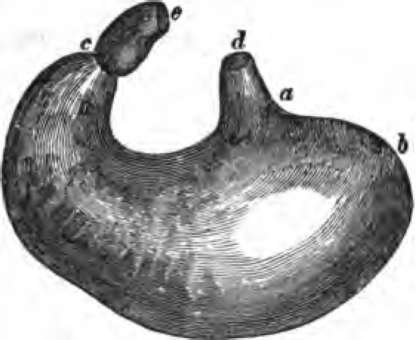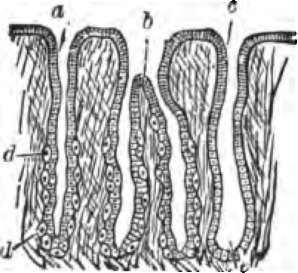The Esophagus Or Gullet
Description
This section is from the book "The Human Body: An Elementary Text-Book Of Anatomy, Physiology, And Hygiene", by H. Newell Martin. Also available from Amazon: The Human Body.
The Esophagus Or Gullet
The Esophagus Or Gullet is a tube commencing at the lower termination of the pharynx and which, passing on through the neck and chest, ends below the diaphragm in the stomach. In the neck it lies close behind the windpipe. The Stomach (Fig. 47) is a curved conical bag placed transversely in the upper part of the abdominal cavity.* Its larger end is turned to the left and lies close beneath the diaphragm, and opening into its upper border, through the cardiac orifice at a, is the gullet, d. The narrower right end is continuous at c with the small intestine; the communication between the two is the pyloric orifice. The pyloric end of the stomach is separated from the diaphragm by the liver (see Fig. 4). When moderately distended the stomach is about twelve inches long, and about four inches across at its widest part, and would contain about three pints.
What apertures open into its ventral side? What is the usual position of the soft palate? How is this position altered during swallowing? What passes through the respiratory division of the pharynx? What things pass through its lower division? What is the destination of each? What is meant by saying a morsel has "gone the wrong way"? Where do the Eustachian tubes open? What is the epiglottis? How may it be seen? What is its use?
* During a severe attack of vomiting the soft palate often only acts imperfectly in closing the passage between gullet and nostrils; hence some of the ejected matter not unfrequently is expelled through the nose.

Fig. 47. The stomach, d, lower end of the gullet; a, position of the cardiac aperture : b, the fundus; c, the pylcrus: e, the first part of the small intestine ; along a, b, c, the great curvature ; between the pylorus and d, the lesser curvature.

Fig. 48. A thin section through the gastric mucous membrane, perpendicular to its surface, magnified about 25 diameters, a, a simple peptic gland; 6, a compound peptic gland; c, a mucous gland.
Describe the gullet. Where does it lie in the neck?
What is the stomach? Which end of it is larger? Where does this end lie? What opens into it? What is the opening called? What is continuous with the small end of the stomach? What is the name of the aperture between the stomach and the small intestine?
* The general anatomical arrangement of the stomach, and its connections with the gullet and intestine, may be readily shown on the body of a puppy, kitten, or rat, which has been killed by placing it for five minutes in a small box containing also a sponge soaked with chloroform.
Continue to:
